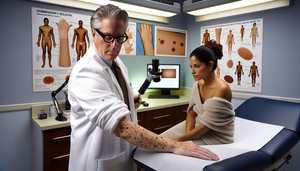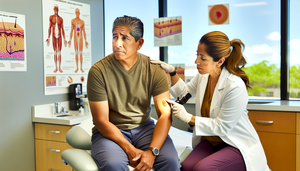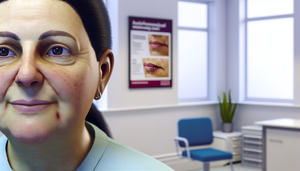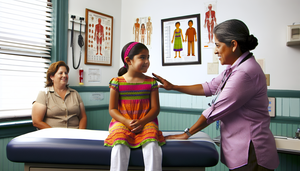
Early Signs of Anal Cancer: Recognizing Symptoms and the Role of Anoscopy in Diagnosis
Early detection of anal cancer through anoscopy improves clinical outcomes in high-risk patients.
Read more
Gallbladder Cancer: Recognizing Right Upper Quadrant Pain and Early Diagnosis Methods for Cholelithiasis
Explore how advancements in imaging and biomarkers enhance the early diagnosis of gallbladder cancer.
Read more
Early Identification of Liver Cancer in Patients at Risk of Cirrhosis: The Role of Alpha-Fetoprotein and Liver Ultrasound in Detecting Focal Liver Lesions
Early detection of liver cancer in cirrhotic patients improves prognosis through ultrasound and alpha-fetoprotein.
Read more
Pancreatic Cancer: Initial Findings, Tumor Markers, and the Role of Endoscopic Ultrasound in Diagnosis
Discover how the combination of tumor markers and new technologies enhances the early diagnosis of pancreatic cancer.
Read more
Esophageal Cancer: Recognizing Progressive Dysphagia for Early Detection and Timely Action
Early detection of progressive dysphagia improves the prognosis of esophageal cancer.
Read more
Gastric Cancer: Key Insights for Early Diagnosis through Upper Gastrointestinal Endoscopy and Biopsy
Early detection of gastric cancer through endoscopy improves prognosis and reduces mortality.
Read more
Colorectal Cancer: Early Detection through Symptom Monitoring and Colonoscopy for Rectal Bleeding and Polyps
Early detection of colorectal cancer through colonoscopy and symptom monitoring reduces mortality.
Read more
Small Cell Lung Cancer: Early Detection, Key Tests, and Respiratory Symptoms
Discover how advancements in biomarkers and non-invasive techniques are enhancing the detection of small cell lung cancer.
Read more
Early Indicators and Diagnostic Tools for Non-Small Cell Lung Cancer: Persistent Cough, Hemoptysis, CT Evaluation, and Bronchoscopy
Early detection of non-small cell lung cancer is enhanced by advanced biomarkers and technology.
Read more
Melanoma: Recognizing Atypical Moles for Early Skin Cancer Diagnosis Using the ABCDE Method
Discover how to identify suspicious moles and enhance early melanoma diagnosis.
Read more
Early Detection and Management of Squamous Cell Carcinoma: Clinical Evaluation of Precancerous Lesions and Actinic Keratosis
Early detection and appropriate management of squamous cell carcinoma prevent its invasive progression.
Read more
Basal Cell Carcinoma: Early Signs of Skin Cancer and Essential Dermatological Examination Techniques
Discover how advanced diagnostic techniques enhance the early detection of basal cell carcinoma.
Read more
Early Breast Cancer Diagnosis: Key Initial Symptoms and Importance of Clinical Breast Examination, Mammography, and Ultrasound
Early detection of breast cancer improves survival through mammograms, ultrasounds, and new biomarkers.
Read more
Alström Syndrome: Identifying Multisystem Signs and Differentiating from Bardet-Biedl in Childhood Obesity and Progressive Hearing Loss
Explore how to differentiate Alström syndrome from Bardet-Biedl syndrome for accurate diagnosis.
Read more
Von Hippel-Lindau Disease: Early Diagnosis, Genetic Screening, and Differentiation from Neurofibromatosis
Early identification and differentiation of VHL and NF1 is crucial for appropriate management.
Read more
Cockayne Syndrome: Assessing Photosensitivity and Differentiating from Xeroderma Pigmentosum through Genetic Testing
Explore how to differentiate Cockayne syndrome from xeroderma pigmentosum through photosensitivity and genetic testing.
Read more
Bardet-Biedl Syndrome: Early Signs, Laurence-Moon Differentiation, and Associated Conditions
Discover how to differentiate Bardet-Biedl syndrome from Laurence-Moon syndrome for accurate diagnosis.
Read more
Behçet's Disease: Detecting Recurrent Oral Ulcers and Differentiating from Systemic Lupus Erythematosus
Discover how to differentiate oral ulcers in Behçet's disease and lupus for accurate diagnosis.
Read more
Turner Syndrome: Recognizing Short Stature and Differentiating from Other Conditions in Karyotype 45,X
Discover how to identify short stature in Turner syndrome and differentiate it from other pathologies.
Read more
Klinefelter Syndrome: Detecting Hypogonadism and Differentiating from Other Causes in 47,XXY Karyotype Patients
Early detection and accurate differentiation of hypogonadism in Klinefelter syndrome optimizes clinical outcomes.
Read more